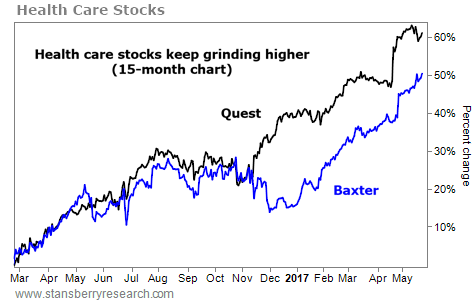| Home | About Us | Resources | Archive | Free Reports | Market Window |
How One Bad Trade Got Trump ElectedBy
Wednesday, May 24, 2017
I have known for a long time now that poor investment decisions have real and serious consequences for individuals and families.
But I never dreamed that a classic investing disaster could have been instrumental in getting a president elected.
It's an astonishing tale. And we can learn from it today...
Steve Bannon is widely credited with helping to get Trump elected president. He's now President Trump's chief strategist.
His father, Marty Bannon, spent 50 years working for AT&T. Over his career, he accumulated a significant position in the company's stock. For Marty, that investment was an insurance policy for his family. If financial disaster ever struck, he believed at least AT&T would keep going strong.
Then, on October 7, 2008, Marty was watching the news. The whole financial system seemed to be unravelling – and his nest egg at AT&T was going down with it. Marty didn't even bother to call his investment-banker son, Steve, to ask for advice. He just panicked, and sold.... his entire position.
In the end, Steve Bannon watched nearly all his investment-banker friends get bailed out by the easy money policies of the federal government, while his father suffered.
The Wall Street Journal recently detailed how this experience cemented Steve's convictions – and his future. From the article...
It was a devastating loss. And it shows how the greed of the establishment created a bubble that put the investments of working-class Americans at risk. But what, as investors, can we learn from it?
A lot...
Not all of them are as consequential as this one, obviously, but it's an important reminder that painful losses can happen in the markets. Investing is not always fun... And the stakes can be high – many investors, like Marty Bannon, set about building a nest egg with retirement and family in mind. Marty ultimately lost more than $100,000 because he sold his shares for less than he paid for them. This may never happen to you... But it is possible.
If you're going to invest, you must be mentally prepared to ride out market downturns. You can't sell everything anytime the market pulls back.
Marty's position in AT&T was too big for him to manage without emotion getting the better of him. It's critical to have the right position sizes. This is never more obvious than in the throes of a market crash. No matter how sure you are of a company's success... no matter how reliable it has been in the past... nothing is certain in the markets. A diversified portfolio spread out over numerous uncorrelated assets will lower your risk. It will keep your individual losses smaller. And it will give you more peace of mind, even during a crisis.
The media are in the business of capturing your attention... And the best way to do that is through your emotions. The media love when you get emotional. It means you're paying attention. The more emotional, the better. If you're going let TV influence your investing, just keep that in mind. According to the Journal, just days before Marty sold, an analyst on the Today Show told viewers to pull money from the market if they needed any cash for the next five years. That kind of warning sure gets people's attention – but it doesn't help investors make good decisions.
It pains me greatly when I hear stories like Marty Bannon's... or like what happened to the employees of Enron, who had been encouraged to invest their life savings into the company's stock.
Unfortunately, this kind of thing happens in the stock market way more often than it should... And the little guys often draw the short straw.
Stories like Marty's get me out of bed in the morning, determined to make TradeStops the investor's best friend... and to help give you confidence and conviction when the going gets tough.
Regards,
Richard Smith
Further Reading:
"Making sure that you don't get hurt too badly when you're wrong is the great secret to ultimately succeeding as an investor," Richard says. Learn how one tool can help you limit your losses and take the emotion out of your investing right here: Time to Double Down.
"Taking risks gives investors opportunities to succeed... So how much risk is the right amount?" Richard writes. Investing isn't a one-size-fits-all process. Your level of "risk tolerance" depends on your unique situation – and a few key factors. Read more here: How Much Risk Are YOU Willing to Take?
Market NotesTHIS BOOM ISN'T STOPPING ANYTIME SOON Today, we're sharing more proof that the bull market in one sector is still going strong...
For the past several years, our colleague David Eifrig has told his subscribers to put their money to work in health care stocks. He has argued that these companies "have one of the world's greatest tailwinds at their backs." As Baby Boomers get older, they'll need to spend more money on prescriptions, medical devices, lab tests, and other health services.
Two health care companies have been benefiting from this megatrend: Baxter International (BAX) and Quest Diagnostics (DGX). Baxter makes systems for treating patients with a range of conditions, including hemophilia and kidney disease. And Quest is the worldwide leader in diagnostic testing, with more than 2,200 centers across the country. Its roughly 43,000 employees serve one in three adult Americans each year.
As you can see below, shares of Baxter (blue line) and Quest (black line) have surged over the last 15 months. They're up around 50% and 60%, respectively, since the end of February last year... And both just hit a fresh all-time high (on a split-adjusted basis). This massive trend is going to be around for years to come...
 |
Recent Articles
|



